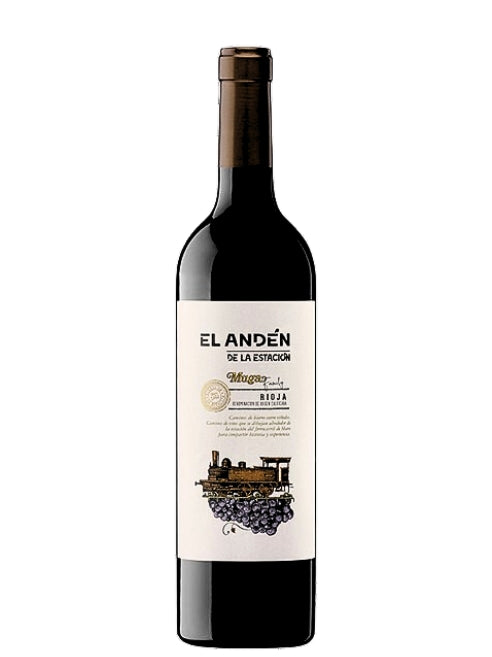Just like France, Spain is a country whose history and culture are closely linked to viticulture.
Among the many Spanish wine regions, La Rioja holds a leading position. Nestled in the north of the country, the eponymous appellation is indeed highly renowned for its elegant and complex red wines. Nevertheless, it also produces, albeit in small quantities, high-quality white wines and rosés.
In this article, we will therefore explore Rioja in depth, examining its history, wines, climate, and terroir, as well as the differences the region presents compared to its illustrious neighbor, Ribera del Duero. We will also look at the ideal food and wine pairings with local cuvées.
Have a good trip ! (Bon voyage)
Summary
History of the Rioja appellation
The history of viticulture in Rioja dates back to Antiquity, when the Phoenicians, then the Romans introduced the vine to the region.
However, it was only in the Middle Ages, under the influence of monasteries and religious orders, that the vineyard truly began to develop. In fact, the first written mention referring to the vine in the region dates back to the 9th century AD.
In the 13th century, the first wines from Rioja began to be exported beyond its borders. Then, from the 15th century onwards, regional trade started to focus significantly on viticulture.
Over the centuries, Rioja continued to gain in reputation, eventually becoming in the 19th century one of the first regions in Spain to establish wine production regulations.
A few decades later, in 1925, the controlled designation of origin "Rioja" was officially created (DOC, Denominación de Origen Controlada). It is one of the first in Spain. In 1991, it achieved the supreme status of Denominación de Origen Calificada (DOCa), a distinction granted to only one other wine region in Spain : Priorat.
Today, the Rioja is probably the best-known Spanish wine appellation in the world.
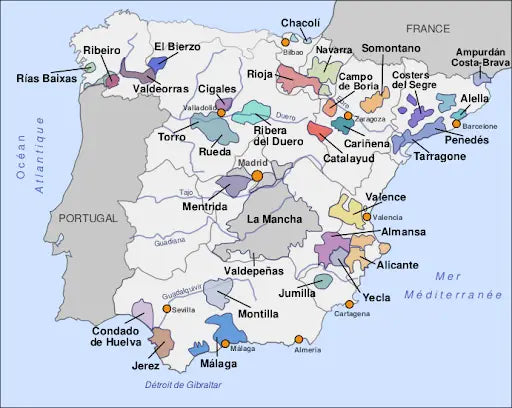
Map of Spanish vineyards with Rioja in the north-central area
The wines of DOCa Rioja
La Rioja is mainly renowned for its red wines. These account for 90% of the region's production and are mainly made from the grape variety Tempranillo.
With medium acidity, Tempranillo features a thick skin and delivers aromas of red and black fruits (plum, prune, blackberry, blackcurrant, etc.), tobacco, chocolate, and even pepper.
This grape variety allows for the production of a wide range of wines, from fruity cuvées to be enjoyed in their youth to fine age-worthy wines that can improve over decades. Aging in oak barrels (mainly American) is very common for this grape, imparting notes of vanilla, cinnamon, clove, etc.
Representing 80% of the regional vineyard area, Tempranillo is often blended with other complementary varieties such as Grenache (Garnacha), Mazuelo (Carignan), Graciano, or even Maturana Tinta.It is with these same 5 grape varieties that the rosés of Rioja are also produced.
But Rioja is also home to delicious white wines. The Viura grape variety is predominant for this color, but other varieties are also planted such as Grenache Blanc (Garnacha Blanca), Malvasia, Tempranillo Blanco or, although more rarely used, Chardonnay and Sauvignon. In total, 9 white grape varieties can be used.
Finally, sparkling wines are also produced in the region and can be made from the 14 grape varieties of the appellation.
The aging of wines in Rioja
In Spain, wines can be classified into several categories according to their aging period in barrels and bottles : Joven, Crianza, Reserva, and Gran Reserva. Although these terms can be used throughout the country, Rioja has the particularity of having established even more demanding specifications for their use.
- Wines labeled “Joven” are young wines, with little or no aging in barrels, highlighting the freshness of the fruit. No minimum aging period in barrel or bottle is required here, whether for reds, whites, or rosés.
- Red wines bearing the mention “Crianza” must be aged for at least two years, of which a minimum of one year must be in oak barrels. White and rosé wines with this mention must also be aged for a minimum total of two years, including 6 months in barrels. Crianza wines therefore generally display fruity aromas as well as woody notes.
- Red wines bearing the mention “Reserva” must be aged in barrels and bottles for a minimum of three years. Of these three years, at least one year must be spent in barrels, complemented by 6 months in the bottle. For whites and rosés, the minimum aging must be a total of two years, including a mandatory 6 months in barrels.Wines in this category are age-worthy wines with great aromatic complexity (fruity, woody notes as well as tertiary aromas such as leather, tobacco, or truffle).
- Finally, the red wines “Gran Reserva” represent the wine elite of the region and are produced only in the best vintages. These must undergo a minimum total aging of 5 years, including 2 years in barrels and 2 years in bottles. For whites and rosés, the total aging is at least 4 years, including 6 months in barrels. Regardless of their color, "Gran Reserva" wines are exceptional age-worthy wines with incredible aromatic richness.
Summary table of the wine aging mentions in Rioja
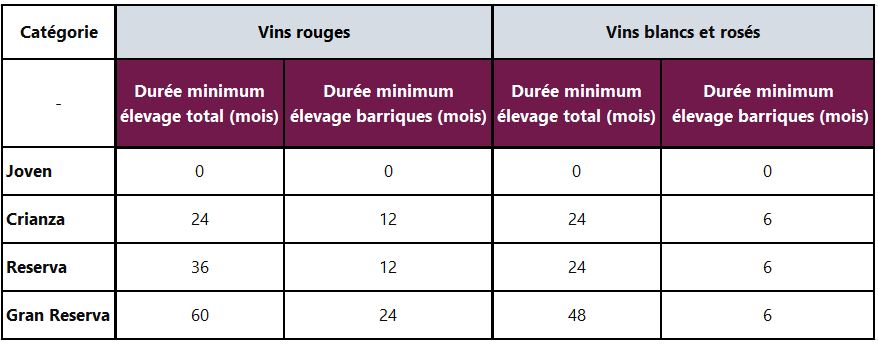
Climate and terroirs of Rioja
The climate of Rioja is continental, characterized by hot, dry summers and harsh winters. Precipitation is moderate here, and the temperature variations between day and night promote optimal grape ripening.
The appellation covers more than 63,000 hectares within the provinces of Rioja, Alava, and Navarre, and is divided into three main zones: Rioja Alta, Rioja Oriental (formerly Rioja Baja), and Rioja Alavesa.
- Rioja Oriental: located in the east and also called Rioja Baja, this area experiences a hot and dry climate and has soils poor in nutrients. The wines produced here are the densest and most concentrated of the appellation.
- Rioja Alta: located in the west, this region benefits from a cooler climate than Rioja Oriental, allowing for the production of elegant wines with beautiful acidity. The vines here are planted at an altitude between 400 and 500m and the soils are clay-limestone.
- Rioja Alavesa: nestled in the foothills of the Sierra Cantabria, this region benefits from a climate similar to that of Rioja Alta but the wines are more intense, while still retaining finesse. The soils are rocky and the vines are also situated between 400 and 500m in altitude.
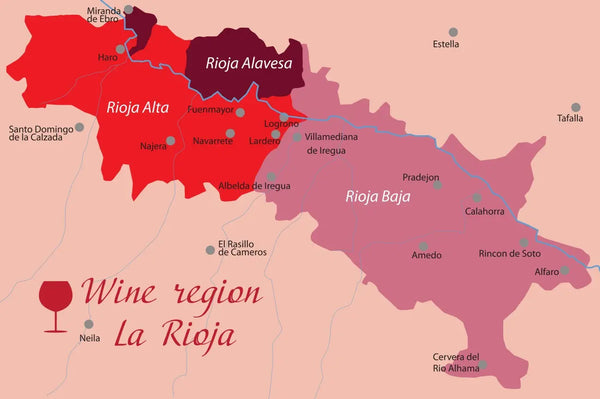
The differences between Rioja and Ribera del Duero
Rioja and Ribera del Duero are the two flagship wine regions of Spain. Both located in the north of the country, they are therefore often compared and contrasted. However, while the two appellations share certain similarities, several factors set them apart.
First of all, although both Rioja and Ribera del Duero have Tempranillo as their signature grape variety (also called Tinta Fina in Ribera del Duero), the other varieties in the two regions are not the same. Thus, while Grenache, Mazuelo, and Graciano are used in Rioja, French varieties such as Cabernet Sauvignon, Merlot, and Malbec are preferred in the Ribera del Duero.
Moreover, the climate of the Ribera del Duero is much more continental than that of Rioja and is therefore characterized by much greater temperature extremes. Rioja, in fact, benefits from a certain oceanic influence, which helps to preserve freshness in its wines. As a result, wines from Ribera del Duero are more powerful and dense than those from Rioja.
From a wine aging perspective, estates in both regions almost systematically age their cuvées in barrels. Nevertheless, the type of wood used for these aging processes is often different.Thus, within the Ribera del Duero, French oak is predominantly used, while in Rioja, wines generally age in contact with American oak, imparting more pronounced spicy and exotic notes (vanilla, coconut, etc.).
As you will have understood, although certain similarities unite the two wine regions, many differences contribute to the uniqueness of the two appellations.
What to pair with Rioja wines?
Thanks to their aromatic diversity, Rioja wines are versatile and pair very well with a wide variety of dishes.
Thus, for a cuvée labeled « Joven » that focuses mainly on fruit, poultry is an ideal pairing, just like a charcuterie board or even a veal roast or herb-crusted pork chops.
For more powerful and complex wines such as Crianza, Reserva, and Gran Reserva, red meat then becomes almost a must. The power and aromatic intensity of these cuvées indeed call for dishes with a certain structure. Thus, prime rib, wild boar, pheasant, or lamb chops will pair divinely well with this type of cuvée.
As for cheeses, this time we recommend favoring white or rosé wines from Rioja.Their structure and fruity notes will indeed pair very well with Manchego, Ossau-Iraty or even Beaufort or Comté. Red wines can also be tried, but be careful not to select bottles that are too tannic!
Finally, still with rosés and white wines, seafood, poultry, and grilled fish will also be a great match.
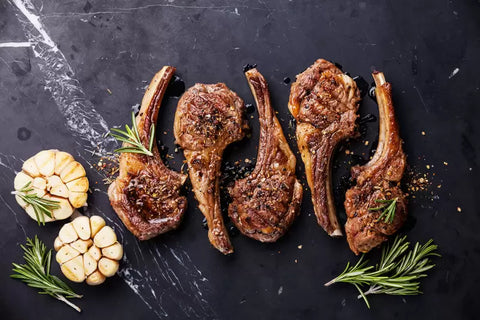
The best wines from Rioja
As you will have understood, Rioja is a fascinating wine region that combines tradition and innovation to produce world-class wines.
If you wish to discover it, many estates are available to you, but we particularly recommend the Bodegas Muga, a renowned name in the region known for producing exceptional wines. Their cuvées provide an excellent overview of what Rioja has to offer. Complexity, elegance, and aging potential are indeed guaranteed !
¡ Salud ! And see you soon at La Cave Éclairée !


